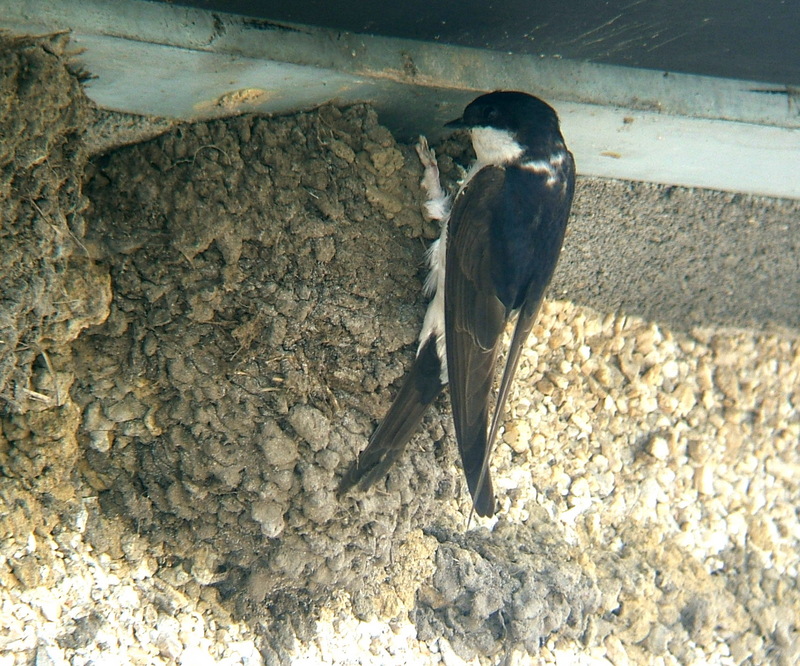|
| Query: Common blue | Result: 817th of 981 | |
House Martin (Delichon urbicum) - wiki
| Subject: | House Martin (Delichon urbicum) - wiki
| |

| Resolution: 1701x1417
File Size: 1011321 Bytes
Date: 2007:08:26 20:23:12
Upload Date: 2007:08:26 20:26:02
|
ERROR : Server Busy(-1105)
ERROR : Server Busy(-1105)
House Martin (Delichon urbicum) - wiki
House Martin
From Wikipedia, the free encyclopedia
[Photo] Delichon urbica at nest, West Woodburn, Northumberland, UK; 31 July 2006
The House Martin (Delichon urbica) is a migratory passerine of the swallow family. It is a bird of open country and human habitation breeding in Europe, north Africa and temperate Asia.
The western nominate race D. u. urbica breeds from Europe across Asia as far east as central Mongolia and winters in tropical Africa. The race D. u. lagopoda breeds further east in temperate Asia, and winters in southern China and Southeast Asia.
The adult House Martin is 13 cm long, steel-blue above with a white rump, and white underparts, including the underwings; even its short legs and toes have white downy feathering. Its bill is black. The young bird is sooty black, and some of the coverts and quills have white tips and edgings.
The white rump of the House Martin, very noticeable in flight, should prevent confusion with either the Swallow or Sand Martin. The first Martins arrive in Europe a few days after the Swallows, but it is often late in April before distribution is general.
They travel with the later waves of incoming Swallows, and like them seldom go straight to the nesting sites, but hunt for food over large waters and roost in reeds.
Nevertheless the bird is just as constant in returning to its old haunts, repairing the nest it built the year before, or making a new one close to the one in which it was reared. It is more likely to nest on house than the outbuildings favoured by Barn Swallows.
Its call is a sibilant twitter, and the male's song is a fast za-za-za.
Its food, and many of its habits, except those connected with nesting, are similar to those of the Swallow; it alights more frequently, and, often aiding progression with uplifted wings, will walk a few steps when collecting mud or feeding.
The House Martin was originally a cliff and cave nester, and some cliff nesting colonies still exist, usually building their nests below an overhanging rock. They now largely use human structure. On houses, the nests are close under the eaves so that they may be strengthened by attachment above.
The nest is a cup fixed below a suitable ledge. The entrance is so small that the House Sparrow cannot take over the nest once the nest is complete. The mud, added in successive layers, is collected from ponds, streams or puddles. Both birds work at construction.
During construction there are frequent quarrels with trespassing sparrows, but if the sparrow remains in possession of a nest the martins build elsewhere.
At all times the House Martin is gregarious, and many nests are built actually in contact; 4 or 5 white eggs are laid as a rule in early June; second and third broods are common, and late nestlings are often left to starve.
For weeks after leaving the nest the young congregate in ever increasing flocks which, as the season advances, may be seen gathering in trees or on housetops or on the wires with Swallows.
By the end of October, most Martins have left their breeding areas, though late birds in November and December are not uncommon.
http://en.wikipedia.org/wiki/House_Martin
| The text in this page is based on the copyrighted Wikipedia article shown in above URL. It is used under the GNU Free Documentation License. You may redistribute it, verbatim or modified, providing that you comply with the terms of the GFDL. |
|
Comments |
|---|
| | Guest |
|
| 흰털발제비 / 흰턱제비 Delichon urbicum ( Northern House Martin ) |
^o^
Animal Pictures Archive for smart phones
^o^
|
|
|

